CHEVROLET TRACKER 1996 Owners Manual
Manufacturer: CHEVROLET, Model Year: 1996, Model line: TRACKER, Model: CHEVROLET TRACKER 1996Pages: 387, PDF Size: 18.54 MB
Page 261 of 387
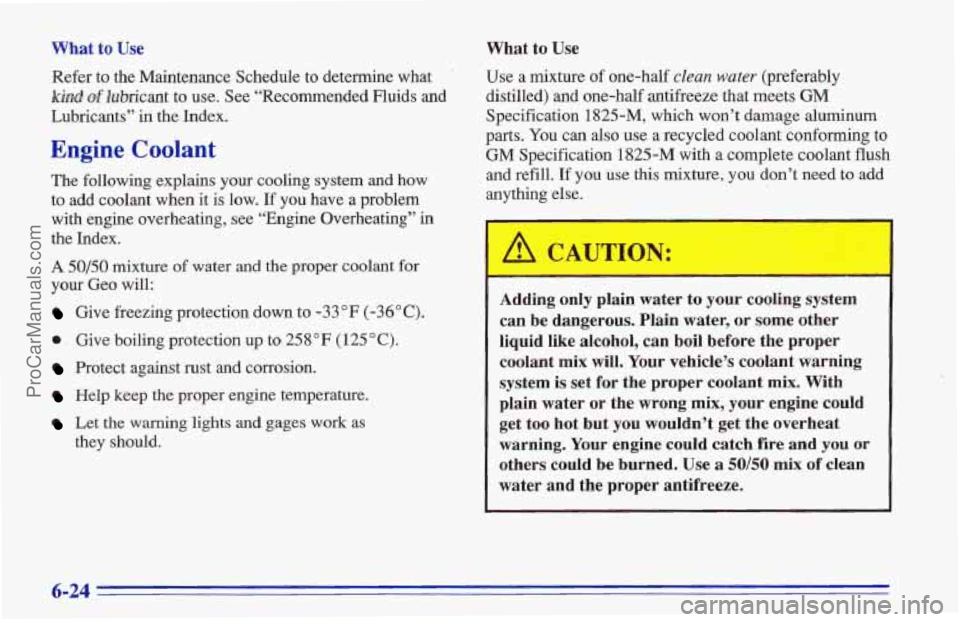
What to Use
Refer to the Maintenance Schedule to determine what
W of lubricant to use. See “Recommended Fluids and
Lubricants”
in the Index.
Engine Coolant
The following explains your cooling system and how
to add coolant when
it is low. If you have a problem
with engine overheating, see “Engine Overheating” in
the Index.
A 50/50 mixture of water and the proper coolant for
your Geo will:
Give freezing protection down to -33 “F (-36°C).
0 Give boiling protection up to 258°F (125°C).
Protect against rust and corrosion.
Help keep the proper engine temperature,
Let the warning lights and gages work as
they should.
What to Use
Use a mixture of one-half clean water (preferably
distilled) and one-half antifreeze that meets
GM
Specification 1825-M, which won’t damage aluminum
parts. You can also use a recycled coolant conforming
to
GM Specification 1825-M with a complete coolant flush
and refill. If you use this mixture, you don’t need to add
anything else.
/i CAUTTON:
Adding only plain water to your cooling system
can be dangerous. Plain water, or some other
liquid like alcohol, can boil before the proper
coolant mix
will. Your vehicle’s coolant warning
system is set for the proper coolant
mix. With
plain water
or the wrong mix, your engine could
get too hot
but you wouldn’t get the overheat
warning. Your engine could catch
fire and you or
others could be burned. Use a 50/50 mix of clean
water and the proper antifreeze.
6-24
ProCarManuals.com
Page 262 of 387
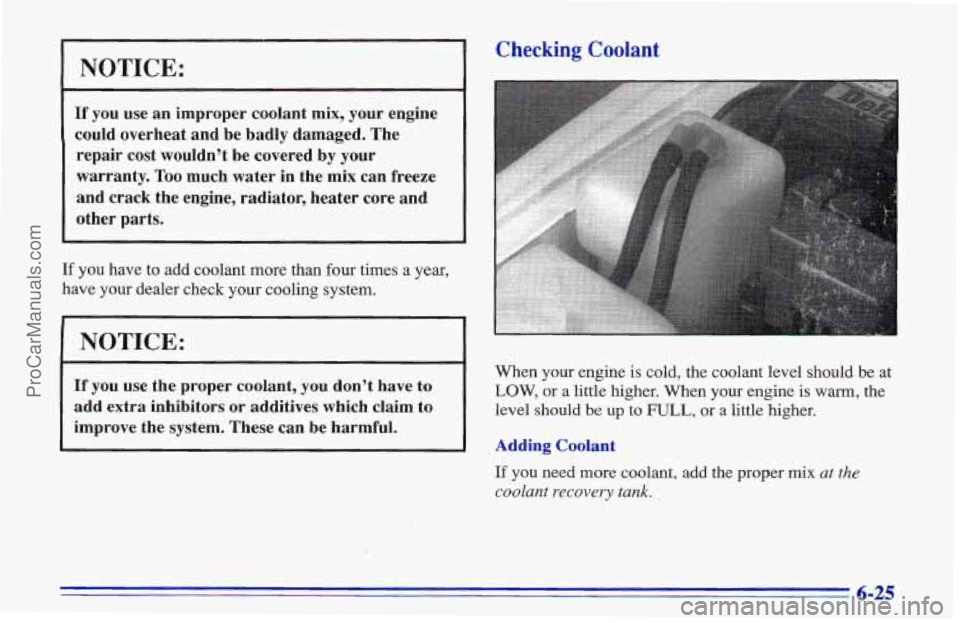
NOTICE:
If you use an improper coolant mix, your engine
could overheat and be badly damaged. The
repair cost wouldn’t be covered by
your
warranty. Too much water in the mix can freeze
and crack the engine, radiator, heater core and
other parts.
If you have to add coolant more than four times a year,
have your dealer check your cooling system.
NOTICE:
r
If you use the proper coolant, you don’t have to
add extra inhibitors or additives which claim to
improve the system. These can be harmful.
Checking Coolant
When your engine is cold, the coolant level should be at
LOW, or
a little higher. When your engine is warm, the
level should be
up to FULL, or a little higher.
Adding Coolant
If you need more coolant, add the proper mix at the
coolant recovery tank.
6-25
ProCarManuals.com
Page 263 of 387
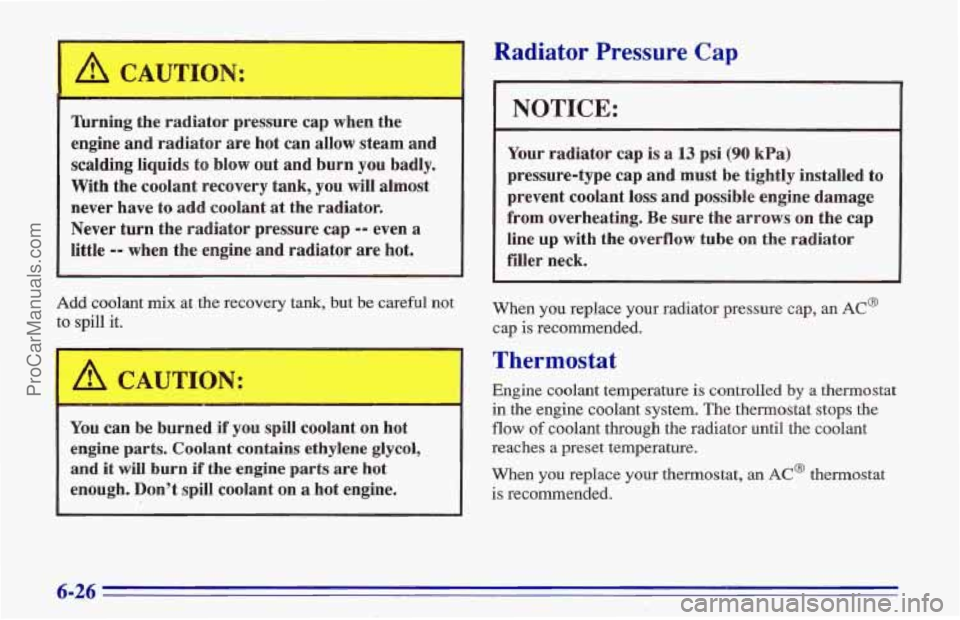
A RI
/t! CAUTION:
lhrning the radiator pressure cap when the
engine
and radiator are hot can allow steam and,
scalding liquids to blow out and burn
you badly.
With the coolant recovery tank, you will almost
never have to add coolant
at the radiator.
Never turn the radiator pressure cap -- even a
little -- when the engine and radiator are hot.
Add coolant mix at the recovery tank, but be careful not
to spill it.
'
A CAUTION:
Radiator Pressure Cap
You can be burned if you spill coolant on hot
engine parts. Coolant contains ethylene glycol,
and it will burn
if the engine parts are hot
enough. Don't spill coolant on
a hot engine.
NOTICE:
Your radiator cap is a 13 psi (90 kPa)
pressure-type cap and must be tightly installed to
prevent coolant
loss and possible engine damage
from overheating. Be sure the arrows on the cap
line up with the overflow tube on the radiator
filler neck.
When you replace your radiator pressure cap, an AC@
cap is recommended.
Thermostat
Engine coolant temperature is controlled by a thermostat
in the engine coolant system. The thermostat stops the
flow of coolant through the radiator until the coolant
reaches a preset temperature.
When you replace
your thermostat, an AC@ thermostat
is recommended.
6-26
ProCarManuals.com
Page 264 of 387
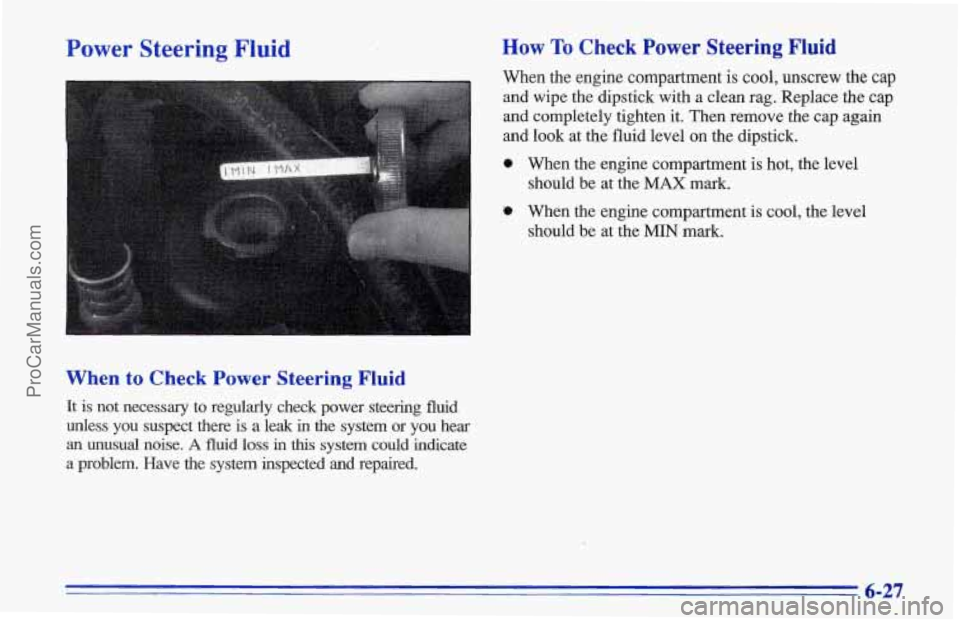
Power Steering Fluid
When to Check Power Steering Fluid
It is not necessary to regularly check power steering fluid
unless you suspect there
is a leak in the system or you hear
an unusual noise. A fluid loss in this system could indicate
a problem. Have the system inspected and repaired.
How To Check Power Steering Fluid
When the engine compartment is cool, unscrew the cap
and wipe the dipstick with a clean rag. Replace the cap
and completely tighten it. Then remove the cap again
and look at the fluid level on the dipstick.
0 When the engine compartment is hot, the level
@ When the engine compartment is cool, the level
should
be at the
MAX mark.
should be at the
MIN mark.
6-27
ProCarManuals.com
Page 265 of 387
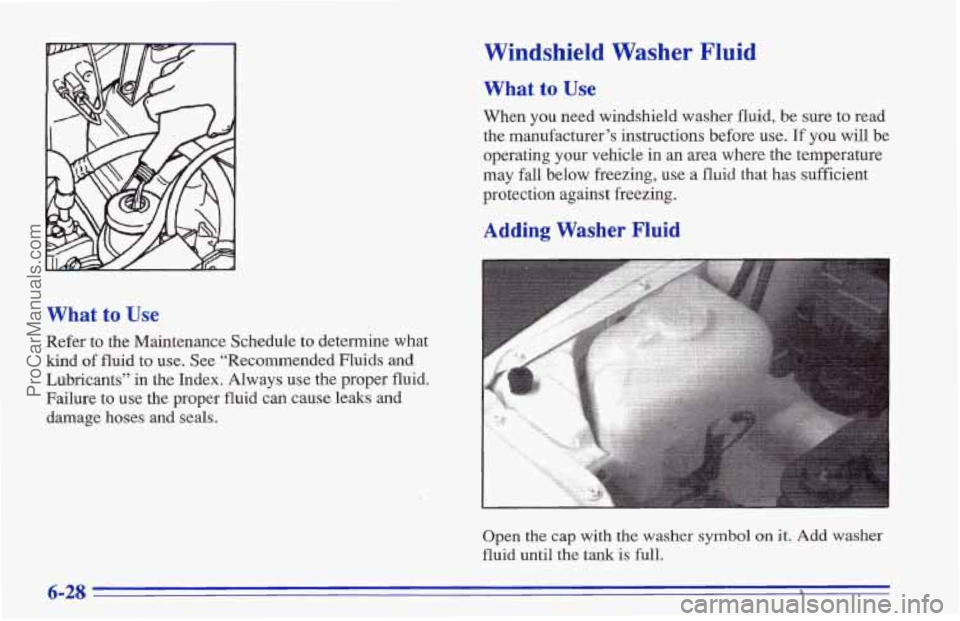
What to Use
Refer to the Maintenance Schedule to determine, what
kind of fluid to use. See ‘‘Recommended Fluids and
Lubricants” in the Index. Always use the proper fluid.
Failure to use the proper fluid can cause leaks and
damage hoses
and seals.
Windshield Washer Fluid
What to Use
When you need windshield washer fluid, be sure to read
the manufacturer’s instructions before use.
If you will be
operating
your vehicle in an area where the temperature
may fall below freezing, use
a fluid that has sufficient
protection
against freezing.
,Adding Washer Fluid
Open the cap with the washer symbol on it. Add washer
fluid until the
tank is full.
6-28 *
ProCarManuals.com
Page 266 of 387
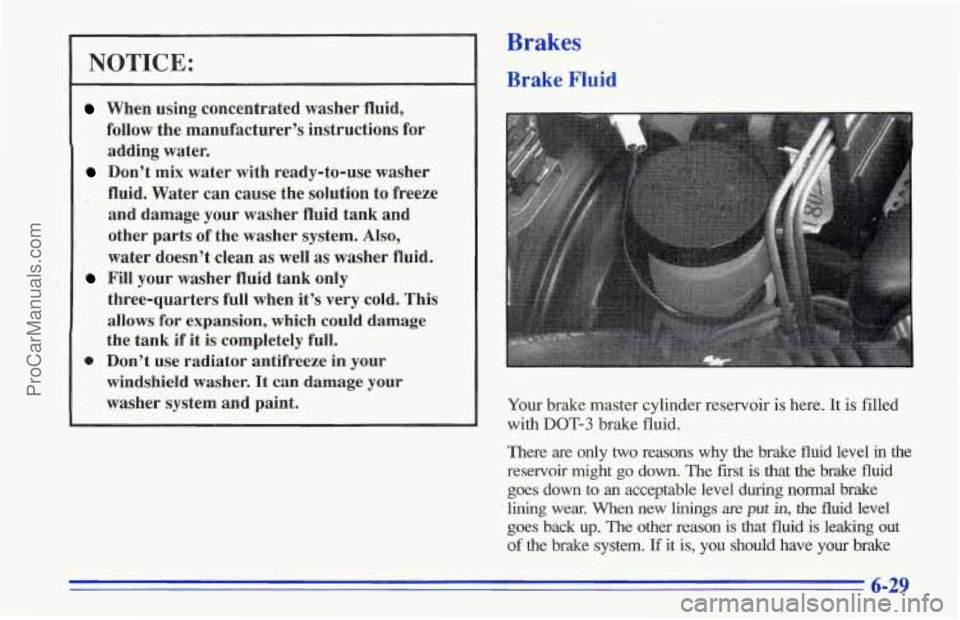
NOTICE:
When using concentrated washer fluid,
follow the manufacturer’s instructions for
adding water.
Don’t mix water with ready-to-use washer
fluid. Water can cause the solution
to freeze
and damage your washer fluid tank and
other parts of the washer system.
Also,
water doesn’t clean as well as washer fluid.
three-quarters full when it’s
very cold. This
allows for expansion, which could damage
the tank
if it is completely full.
windshield washer.
It can damage your
washer system and paint.
Fill your washer fluid tank only
0 Don’t use radiator antifreeze in your
Brakes
Brake Fluid
Your brake master cylinder reservoir is here. It is filled
with
DOT-3 brake fluid.
There are only two reasons why the brake fluid level
in the
reservoir might go down. The first is that the brake fluid
goes down to
an acceptable level during normal brake
lining wear. When new linings are put in, the fluid level
goes back up.
The other reason is that fluid is leaking out
of the brake system.
If it is, you should have your brake
6-29
ProCarManuals.com
Page 267 of 387
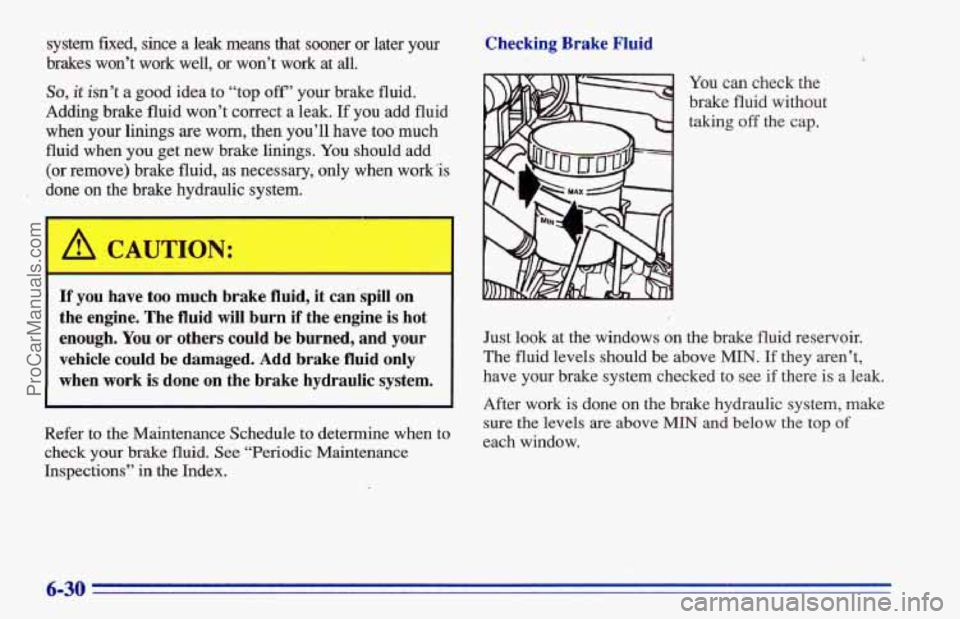
system fixed, since a leak means that sooner or later your
brakes won’t work well, or won’t work at all.
So, it isn’t a good idea to “top off’ your brake fluid.
Adding brake fluid won’t correct a leak.
If you add fluid
when your linings
are worn, then you’ll have too much
fluid when
you get new brake linings. You should add
(or remove) brake fluid, as necessary, only when work ’is
done on the brake hydraulic system.
A CAUTION:
If you have too much brake fluid, it can spill on
the engine. The fluid will burn if the engine is hot
enough.
You or others could be burned, and your
vehicle could be damaged. Add brake fluid only
when work
is done on the brake hydraulic system.
Refer to the Maintenance Schedule to determine when to
check your brake fluid. See “Periodic Maintenance
Inspections” in the Index.
Checking Brake Fluid
You can check the
brake fluid without taking
off the cap.
Just look at the windows on the brake fluid reservoir.
The fluid levels should be above
MIN, If they aren’t,
have your brake system checked
to see if there is a leak.
After work is done on the brake hydraulic system, make
sure the levels
are above MIN and below the top of
each window.
ProCarManuals.com
Page 268 of 387
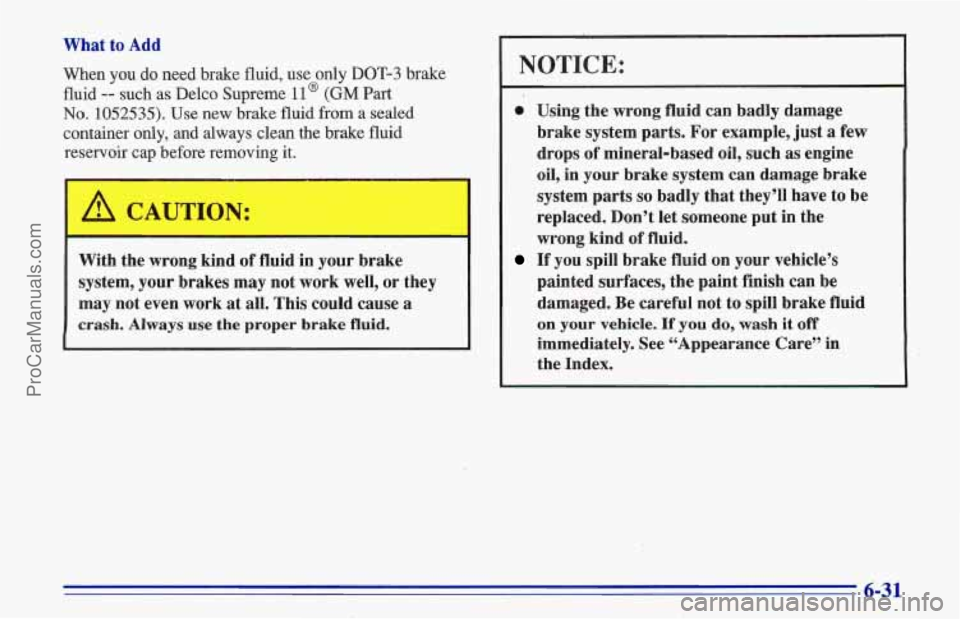
What to Add
When you do need brake fluid, use only DOT-3 brake
fluid
-- such as Delco Supreme 11 @ (GM Part
No. 1052535). Use new brake fluid from a sealed
container only, and alvir-ays clean the brake fluid
reservoir cap before removing
it.
I d!L CAUTION:
1
With the wrong kind of fluid in your brake
system, your brakes may not work well, or they
may not even work at all. This could cause
a
crash. Always use the proper brake fluid.
NOTICE:
e Using the wrong fluid can badly damage
brake system parts. For example, just
a few
drops of mineral-based oil, such as engine
oil, in your brake system can damage brake
system parts
so badly that they’ll have to be
replaced. Don’t let someone put in the
wrong kind of fluid.
If you spill brake fluid on your vehicle’s
painted surfaces, the paint finish can be
damaged. Be careful not to spill brake fluid
on your vehicle. If you do, wash it off
immediately. See “Appearance Care” in
the Index.
6-31
ProCarManuals.com
Page 269 of 387
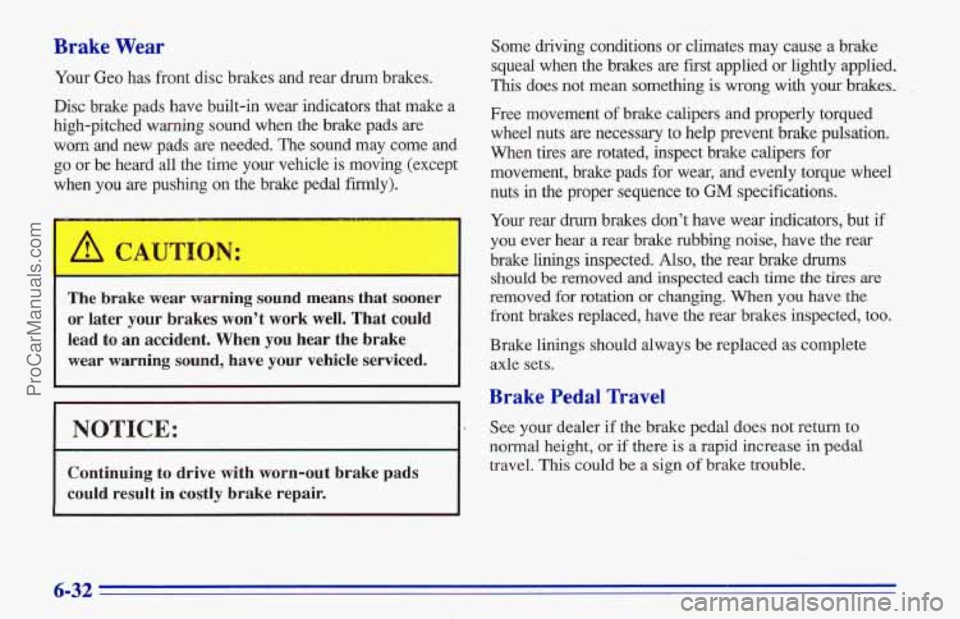
Brake Wear
Your Geo has front disc brakes and rear drum brakes.
Disc brake pads have built-in wear indicators that make a
high-pitched warning sound when the brake pads are
wor~ and new pads are needed.
The sound may come and
go or be heard all the time your vehicle is moving (except
when you are pushing
on the brake pedal firmly).
The brake wear warning sound means that sooner
or later your brakes won’t work
well. That could
lead
to an accident. When you hear the brake
wear warning
sound, have your vehicle serviced.
I NOTICE: I
Continuing to drive with worn-out brake pads
could result
in costly brake repair.
Some driving conditions or climates may cause a brake
squeal when the brakes are first applied or lightly applied.
This does not mean something is wrong with
your brakes,
Free movement of brake calipers and properly torqued
wheel nuts are necessary to help prevent brake pulsation.
When tires are rotated, inspect brake calipers for
movement, brake pads for wear, and evenly torque wheel
nuts
in the proper sequence to GM specifications.
Your rear drum brakes don’t have wear indicators, but
if
you ever hear a rear brake rubbing noise, have the rear
brake
linings inspected. Also, the rear brake drums
should be removed and inspected each time the tires are
removed for rotation or changing. When you have the
front brakes replaced, have the rear brakes inspected,
too.
Brake linings should always be replaced as complete
axle sets.
Brake Pedal Travel
See your dealer if the brake pedal does not return to
normal height,
or if there is a rapid increase in pedal
travel. This could
be a sign of brake trouble.
6-32
ProCarManuals.com
Page 270 of 387
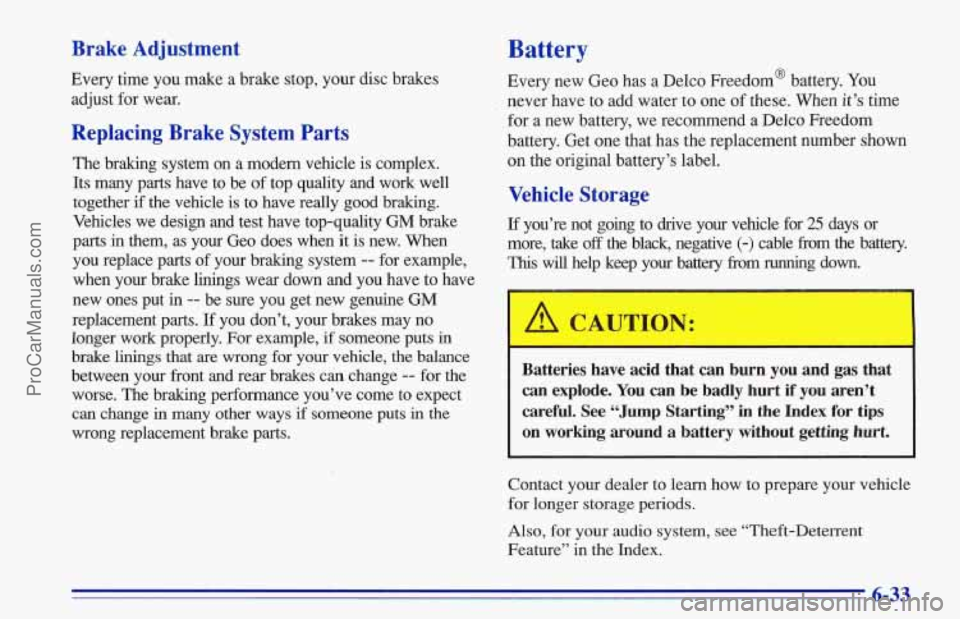
Brake Adjustment
Every time you make a brake stop, your disc brakes
adjust for wear.
Replacing Brake System Parts
The braking system on a modern vehicle is complex.
Its many parts have to be
of top quality and work well
together
if the vehicle is to have really good braking.
Vehicles we design and test have top-quality
GM brake
parts in them, as your Geo does when it
is new. When
you replace parts
of your braking system -- for example,
when your brake
linings wear down and you have to have
new ones put in
-- be sure you get new genuine GM
replacement parts. If you don’t, your brakes may no
longer work properly. For example,
if someone puts in
brake linings that are wrong for your vehicle, the balance
between your front and rear brakes can change
-- for the
worse. The braking performance you’ve come to expect
can change
in many other ways if someone puts in the
wrong replacement brake parts.
Battery
Every new Geo has a Delco Freedom@ battery. You
never have to add water to one of these. Men it’s time
for a new battery, we recommend a Delco Freedom
battery. Get one that has the replacement number
shown
on the original battery’s label.
Vehicle Storage
Tf you’re not going to drive your vehicle for 25 days or
more, take
off the black, negative (-) cable from the battery.
This will help keep your battery from running down.
CAUTION:
Batteries have acid that can burn you and gas that
can explode. You can be badly hurt if you aren’t
careful. See “Jump Starting”
in the Index for tips
on working around
a battery without getting hurt.
Contact your dealer to learn how to prepare your vehicle
for longer storage periods.
Also,
for your audio system, see “Theft-Deterrent
Feature”
in the Index.
ProCarManuals.com